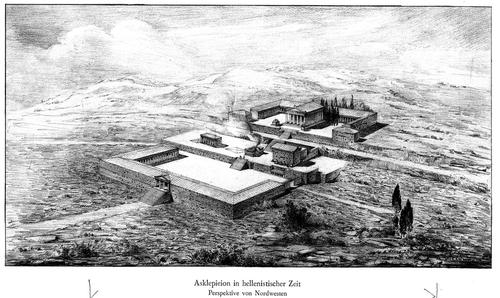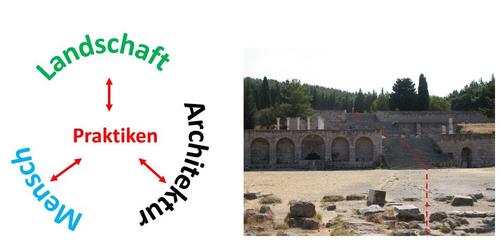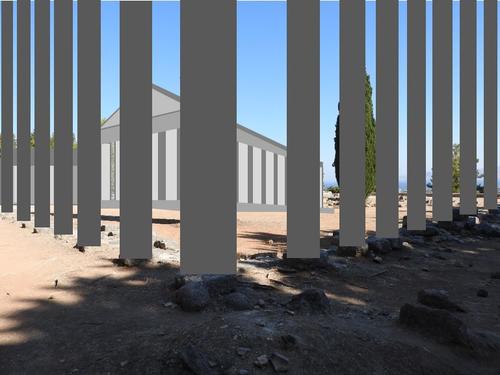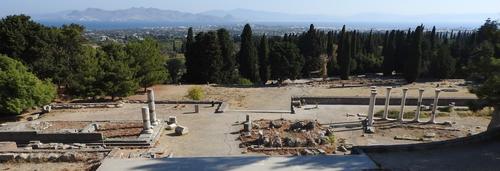Dynamic Spaces: Action and Perception in Hellenistic-Roman Sanctuaries (habilitation / second book)
Fig. 1: Kos - model
Image Credit: Schazmann, Asklepieion, Berlin 1932, pl. 40
Fig. 2: space model
Image Credit: Zeichnung & Foto - Asja Müller
Fig. 3: Kos, upper terrace, reconstruction
Image Credit: Asja Müller
Fig. 4: Epidauros
Image Credit: Asja Müller
Fig. 5: Messene
Image Credit: Asja Müller
Fig. 6: Kos
Image Credit: Asja Müller
Fig. 7: Pergamon
Image Credit: Asja Müller
Project director: Dr. Asja Müller
The research project, which emerged from an appointment to CRC 1266 »Scales of Transformation« at Kiel University, focuses on the interplay of landscape, architecture and people from the Late Classical period through Hellenism to the High Imperial period.
Hans Lauter had already worked out in the 1980s that Hellenism in particular proves to be a key moment in the relationship between people and their environment, for it is characterised by a more conscious use of landscape and architectural elements, which were used specifically to create vistas and prospectuses, and then in turn formed the basis for architectural trends in the Imperial period. Lauter's analysis, however, was based on a very static concept of action developed on floor plans and models from a bird's eye view (Fig. 1).
The approach of the research project described here, however, is different; it specifically asks about the interaction of human actors, landscape and architecture. To this end, it draws on various theoretical models of sociological research, such as those of Bruno Latour and Martina Löw, who conceive of human-object relationships and thus also built space as a dynamic, relational construct of physical constituents in interaction (landscape – architecture – living bodies). As Henri Lefebvre worked out, space is socially produced in this process and, with Theodore Schatzki, the social element that arranges the physical constituents in ever new constellations can be understood as practice (Fig. 2).
Both the objective and the approach of the research project are derived from this: the relationship between landscape and architecture is to be investigated in interaction with human modes of movement and perception as a fundamental form of social practice, i.e. the ground perspective (Fig. 3). Methodologically, the investigation is based on archaeological field studies, information from research literature and digital, three-dimensional models.
On this basis, one architectural function type in particular lends itself to analysis: Sanctuaries, as these are characterised by a basically comparable set of building modules (cult building, altar, temenos boundaries, possibly banqueting buildings, well houses, propyla, etc.) and were designed for relatively concrete (ritual) actions.
A certain type of sanctuary, the Asklepieia, is particularly suitable for this purpose. Due to their main (re)construction periods in the Late Classical (e.g. Epidauros, Fig. 4), Hellenistic (e.g. Messene and Kos, Figs. 5-6) and High Imperial (e.g. Pergamon, Fig. 7) periods, these complexes are not only particularly well suited for studying the changing characteristics of built space in a diachronic perspective. At the same time, Asklepieia also have the most extensive stock of written sources, which enables the reconstruction of the habitus of movement and perception of specific types of actors (foreign theoroi [festival observers]/local citizens) as well as patterns of action (festival/healing ritual). In this way, the diversity of the built space can be specifically brought into view.
The declared aim of the research project is therefore to investigate how the spatial experience of these actors was shaped in these practices in Hellenistic-Roman sanctuaries, what was intended by them and to what extent a change can be seen here from the Late Classical period to the Imperial period.






